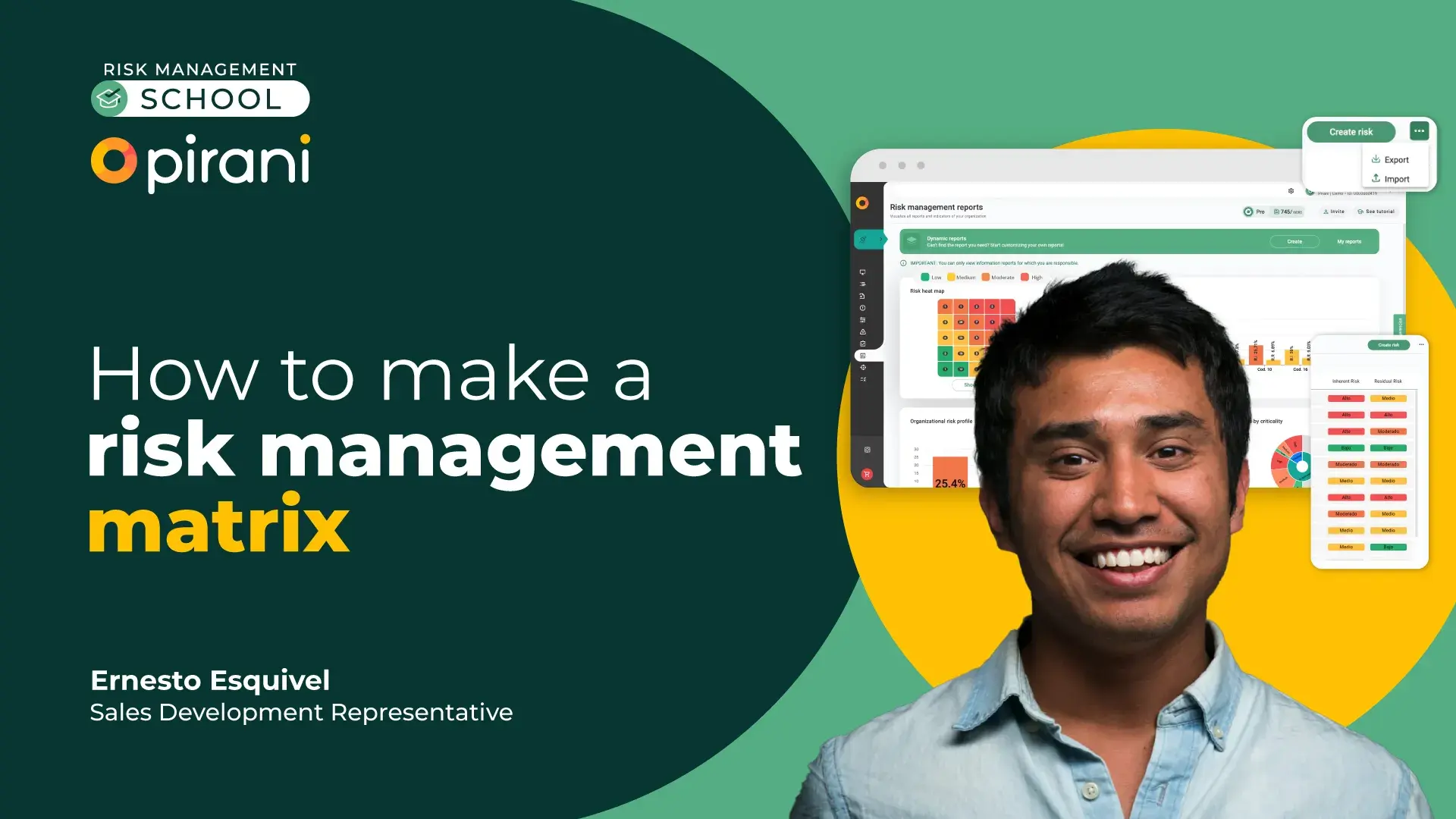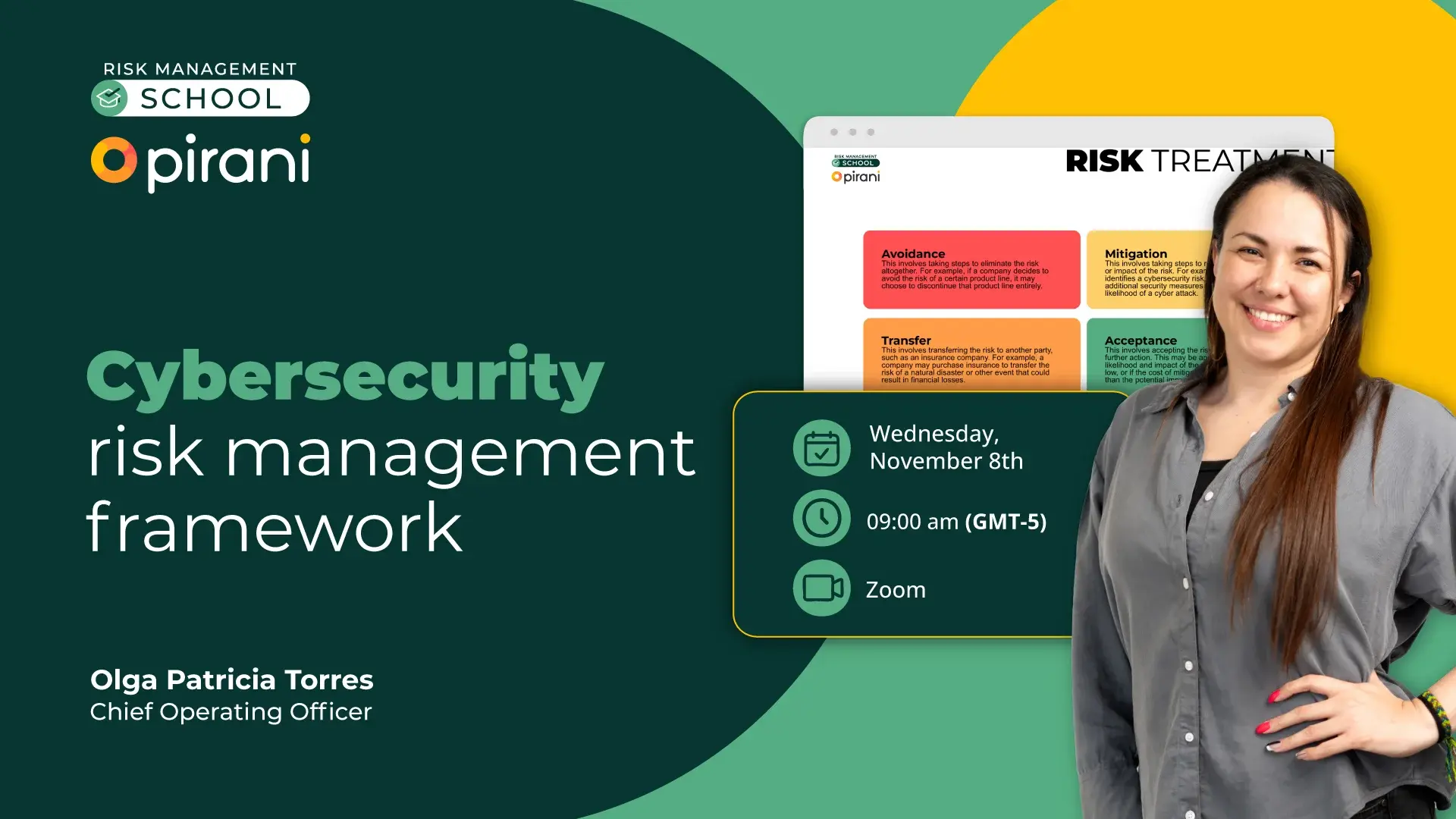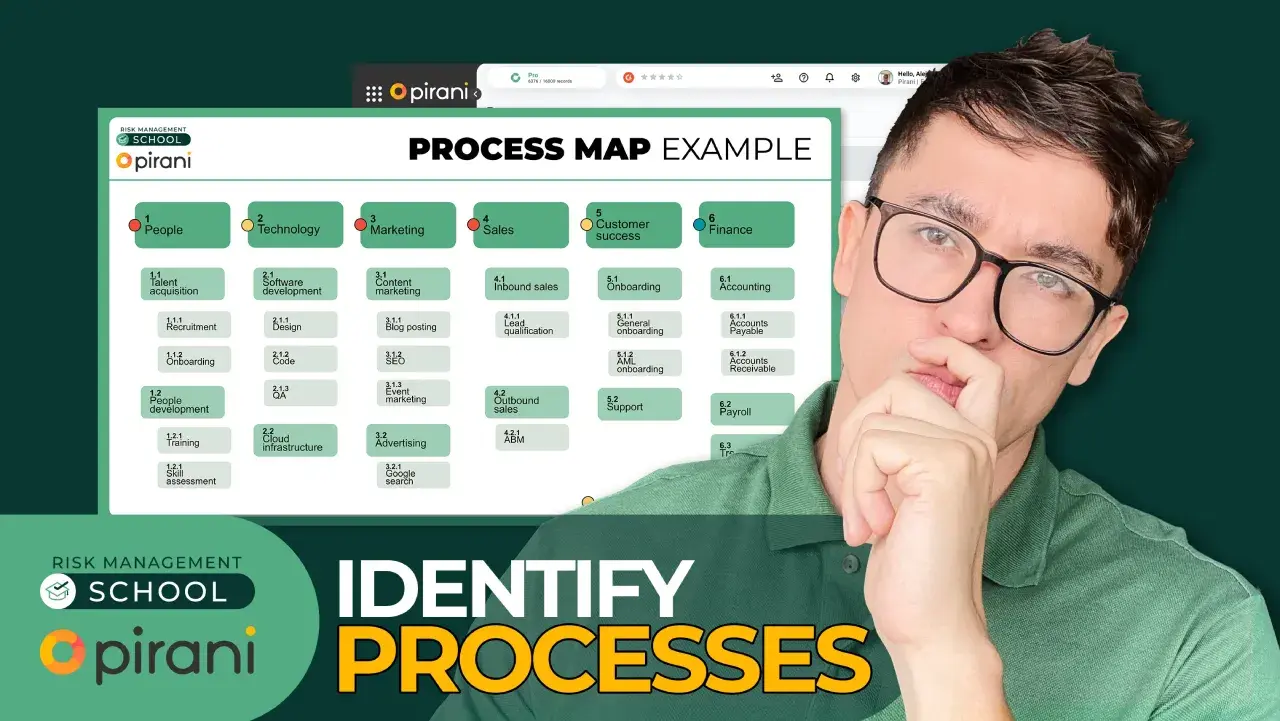Continuous Improvement through Action Plans and Assessments
by Risk Management School on 14 de July de 2023
🎓 Risk management school
In this session, Alejandro Orrego, CEO of Pirani, teaches us why continuous improvement is significant, the essential points, how improvements can be implemented through step-by-step action plans, the keys to performing assessments, and how to rely on Pirani for better monitoring.
Continuous improvement
Refers to an ongoing process of identifying, assessing, and mitigating organizational risks. It involves constantly monitoring and evaluating risks, implementing controls and measures to minimize their impact, and seeking opportunities to enhance risk management practices.
By embracing continuous improvement in risk management, organizations can proactively identify and address potential risks, enhance their resilience, and create a culture of risk awareness and adaptability. It is an ongoing process that helps organizations stay ahead of emerging risks and evolving business environments.
Essentials
1. Risk Identification, Risk Assessment, Risk Mitigation
2. Monitoring and Review: Continuous improvement requires ongoing monitoring of risks to identify any changes in their likelihood or impact. Regular reviews of risk management processes and controls are conducted to evaluate their effectiveness and identify areas for improvement.
3. Learning and Adaptation: Continuous improvement in risk management involves learning from past incidents or near-misses and adapting strategies accordingly. Lessons learned are used to refine risk management practices, update policies and procedures, and enhance the organization's overall resilience to future risks.
4. Stakeholder Engagement: Engaging stakeholders, such as employees, customers, suppliers, or regulators, is essential for effective risk management. Continuous improvement involves seeking feedback, incorporating different perspectives, and ensuring that risk management practices align with the organization's objectives and stakeholder expectations.
Actions plans
Creating action plans with specific activities and responsibilities is an effective way to implement continuous improvement in risk management. Here's a step-by-step guide to help you create action plans for continuous improvement:
Step-by-step guide
- Identify Improvement Areas: Review your existing risk management processes and identify areas that require improvement. This could include risk identification, assessment, mitigation, monitoring, or stakeholder engagement gaps.
- Set Clear Objectives: Define clear objectives for each improvement area. For example, your objective might be to enhance the effectiveness of risk assessments or to strengthen communication channels for reporting risks.
- Define Activities: Break down each improvement objective into specific activities or tasks. Ensure that these activities are actionable, measurable, and achievable. For example, if your objective is to enhance risk assessments, activities might include reviewing and updating assessment methodologies, training risk assessors, or conducting pilot assessments.
- Assign Responsibilities: Assign responsibilities to individuals or teams for each activity. Ensure the assigned individuals have the knowledge, skills, and authority to carry out the tasks effectively. This promotes accountability and ensures that progress is tracked.
- Establish Timelines: Set realistic timelines for each activity. Consider the complexity of the tasks, available resources, and other ongoing initiatives. Clearly communicate the deadlines to the responsible individuals or teams.
- Implement and Monitor: Initiate the implementation of the action plan according to the defined activities and timelines. Regularly monitor progress to ensure that activities are being completed as planned. Use project management software or tracking spreadsheets to track and document progress.
- Evaluate and Adjust: Periodically evaluate the effectiveness of the implemented activities. Assess whether the defined objectives are being met and whether the activities yield the desired outcomes. Based on the evaluation, make necessary adjustments to the action plan, activities, responsibilities, or timelines.
- Document Lessons Learned: Document lessons learned throughout the continuous improvement process. This includes successes, challenges, and insights gained. These lessons can inform future improvements and help in developing best practices.
- Communicate and Train: Communicate the progress and outcomes of the continuous improvement efforts to relevant stakeholders. Share the successes, challenges, and lessons learned. Provide training and guidance to employees involved in risk management to ensure their understanding and engagement with the improvements.
Continuous improvement
- Act (Adjust, adapt, adopt)
- Plan
- Check
- Do
Remember that continuous improvement is an iterative process, so it's important to regularly review and update your action plans to address emerging risks and changing organizational needs.
Assessments
Assessments from third parties can play a valuable role in the continuous improvement of risk management. Third-party assessments provide an independent perspective on your organization's risk management practices and can offer insights, recommendations, and validation of your efforts. Here are some key points to consider when involving third parties in your risk management assessments:
Key points
- Selection of Third-Party Assessors: Choose reputable and qualified third-party assessors with expertise in risk management. Look for assessors who have experience in your industry and understand the specific risks and regulations relevant to your organization.
- Scope and Objectives: Clearly define the scope and objectives of the assessment to ensure that the third party understands your expectations. Communicate the areas or processes you want them to evaluate and provide access to relevant documentation and information.
- Assessment Methodology: Discuss and agree upon the assessment methodology with the third party. This could involve reviewing documentation, conducting interviews with key personnel, analyzing data, or performing on-site inspections. Ensure that the assessment approach aligns with your organization's needs and comprehensively evaluates your risk management practices.
- Collaboration and Information Sharing: Foster open communication and collaboration with third-party assessors. Share relevant information, including policies, procedures, risk assessments, incident reports, and ongoing improvement initiatives. This will help them better understand your organization and provide more meaningful recommendations.
- Assessment Report: Upon completion of the assessment, the third party should provide a detailed report outlining their findings, observations, and recommendations. The report should highlight areas of strength and weakness in your risk management practices, identify gaps or opportunities for improvement, and offer practical suggestions for enhancing your risk management efforts.
- Action Plan and Follow-up: Based on the third-party assessment report, develop an action plan to address the identified areas for improvement. Assign responsibilities, set timelines, and track progress. Regularly review and update the action plan to ensure improvements are implemented effectively.
- Continuous Engagement: Consider incorporating third-party assessments into your ongoing risk management processes. Regularly engage with third-party assessors to conduct periodic assessments, benchmark against industry best practices, and validate the effectiveness of your continuous improvement efforts.
- Integration of Recommendations: Actively integrate the recommendations provided by third-party assessors into your risk management practices. Consider their insights, lessons learned, and best practices, and adapt them to suit your organization's specific needs and culture.
Remember that third-party assessments are an additional tool for continuous improvement and should complement your internal risk management processes. They provide an external perspective and independent validation of your efforts, helping you gain insights and leverage best practices from experts in the field.
In some organizations, a second-party assessment may involve a specialized team or an independent unit that conducts risk management assessments. This can provide an additional layer of objectivity and oversight to ensure that risk management practices are effectively implemented and followed.
You May Also Like
These Related Stories

How to make a risk management matrix

Cybersecurity risk management framework



No Comments Yet
Let us know what you think